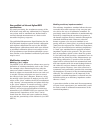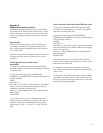
21
Again, cal kit labels should be chosen to best
describe the calibration devices. The “B.1” default
suffix corresponds to the kit’s mechanical revision
(B) and mathematical revision (1).
Note
To prevent confusion, if any standard definitions
in a calibration kit are modified but a new kit label
is not entered, the default label will appear with
the last character replaced by a “*”. This is not the
case if only a class is redefined without changing a
standard definition.
The WR-62 waveguide calibration kit can be
labeled simply – P BAND.
Enter standards/classes
The specifications for the Standard Definition
table and Standard Class Assignments table can be
entered into the 8510 through front panel menu-
driven entry or under program control by an exter-
nal controller. The procedure for entry of standard
definitions, standard labels, class assignments,
class labels, and calibration kit label is described
in Appendix A.
Note
DO NOT exit the calibration kit modification
process without saving the calibration kit defini-
tions in the appropriate register in the 8510.
Failure to save the redefined calibration kit will
result in not saving the new definitions and the
original definitions for that register will remain.
Once this process is completed, it is recommended
that the new calibration kit should be saved on
tape.
Verify performance
Once a measurement calibration using a particular
calibration kit has been generated, its performance
should be checked before making device measure-
ments. To check the accuracy that can be obtained
using the new calibration kit, a device with a well
defined frequency response (preferably unlike any
of the standards used) should be measured. It is
important to note that the verification device must
not be one of the calibration standards. Calibrated
measurement of one of the calibration standards is
merely a measure of repeatability.
A performance check of waveguide calibration kits
is often accomplished by measuring a zero length
short or a short at the end of a straight section of
waveguide. The measured response of this device
on a polar display should be a dot at 1 ∠ 180°. The
deviation from the known is an indication of the
accuracy. To achieve a more complete verification
of a particular measurement calibration, (including
dynamic accuracy) accurately known verification
standards with a diverse magnitude and phase
response should be used. NBS traceable or Agilent
standards are recommended to achieve verifiable
measurement accuracy. Further, it is recommend-
ed that verification standards with known but dif-
ferent phase and magnitude response than any of
the calibration standards be used to verify per-
formance of the 8510.


















